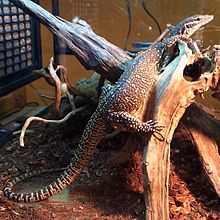Peacock monitor
| Peacock monitor | |
|---|---|

| |
| Scientific classification | |
| Domain: | Eukaryota |
| Kingdom: | Animalia |
| Phylum: | Chordata |
| Class: | Reptilia |
| Order: | Squamata |
| Family: | Varanidae |
| Genus: | Varanus |
| Subgenus: | Odatria |
| Species: | V. auffenbergi
|
| Binomial name | |
| Varanus auffenbergi Sprackland, 1999[1]
| |
The peacock monitor (Varanus auffenbergi), also known as Auffenberg's monitor, is a species of small monitor lizards native to the island of Rote Island, Indonesia.[2] It belongs to the subgenus Odatria.[2]
Etymology
The generic name Varanus is derived from the Arabic word waral ورل, (alternative spelling waran= "lizard"). The name comes from a common semitic root ouran, waran, or waral, meaning "lizard".[3] The occasional habit of varanids to stand on their two hind legs and to appear to "monitor" their surroundings may have led to this name, as it was Latinized into Varanus. The specific name auffenbergi honors US herpetologist Walter Auffenberg.[4]
Description
The peacock monitor is one of the smaller monitor lizards, usually reaching a length of 60 cm (23.5 in).[2] It is similar to the Timor monitor (V. timorensis), with some differentiation in the underside coloring and patterns. The coloring patterns fade as these lizards reach adulthood. They have blue-grey ocelli, whereas the Timor monitor has cream-colored ocelli.[5]
Behavior
In the wild, peacock monitors have been seen climbing the trunks of palms and then basking on their crowns.[6] They are calm and shy compared to other monitor lizards. Peacock monitors remain shy even in captivity.[2]
References
- ^ "ITIS.gov". Retrieved 10 February 2010.
- ^ a b c d "Reptiliana.wordpress.com". (Retrieved Feb. 10, 2010.)
- ^ Sprackland, Robert George (1992). Giant lizards. Neptune, New Jersey: T.F.H. Publications. p. 61. ISBN 0-86622-634-6.
- ^ Beolens, Bo; Watkins, Michael; Grayson, Michael (2011). The Eponym Dictionary of Reptiles. Baltimore, Maryland: Johns Hopkins University Press. xiii + 296 pp. ISBN 978-1-4214-0135-5. (Varanus auffenbergi, p.12).
- ^ monitor-lizards.net Archived 2010-05-19 at the Wayback Machine (Retrieved Feb. 10, 2010.)
- ^ Del Canto, R. Notes on the occurrence of Varanus auffenbergi on Roti Island. Biawak Quarterly Journal of Varanid Biology and Husbandry, Vol 1 No 1., August 2007
Further reading
- JCVI.org (Downloaded Feb. 10, 2010.)
- Varanaus.nl (Downloaded Feb. 10, 2010.)
- ITIS.gov (Downloaded Feb.11, 2010)
- Museumstuff.com (Downloaded Feb.11, 2010)
- Wesiak, K., Unterbringung, Pflege und Nachzucht von Varanus (1999). (Odatria) auffenbergi SPRACKLAND [Housing, care and breeding of Varanus (Odatria) auffenbergi SPRACKLAND 1999.
- Green, Brian & Dennis Goanna King (1999). Monitors : The Biology of Varanid Lizards, 2nd ed. Krieger Publishing Company, Malabar.
- King, Ruth Allen; Pianka, Eric R.; King, Dennis (2004). Varanoid Lizards of the World. Bloomington: Indiana University Press. pp. 225–229. ISBN 0-253-34366-6.
- King, Dennis & Green, Brian. (1999). Goannas: The Biology of Varanid Lizards. University of New South Wales Press. ISBN 0-86840-456-X
- Behavior video on YouTube
